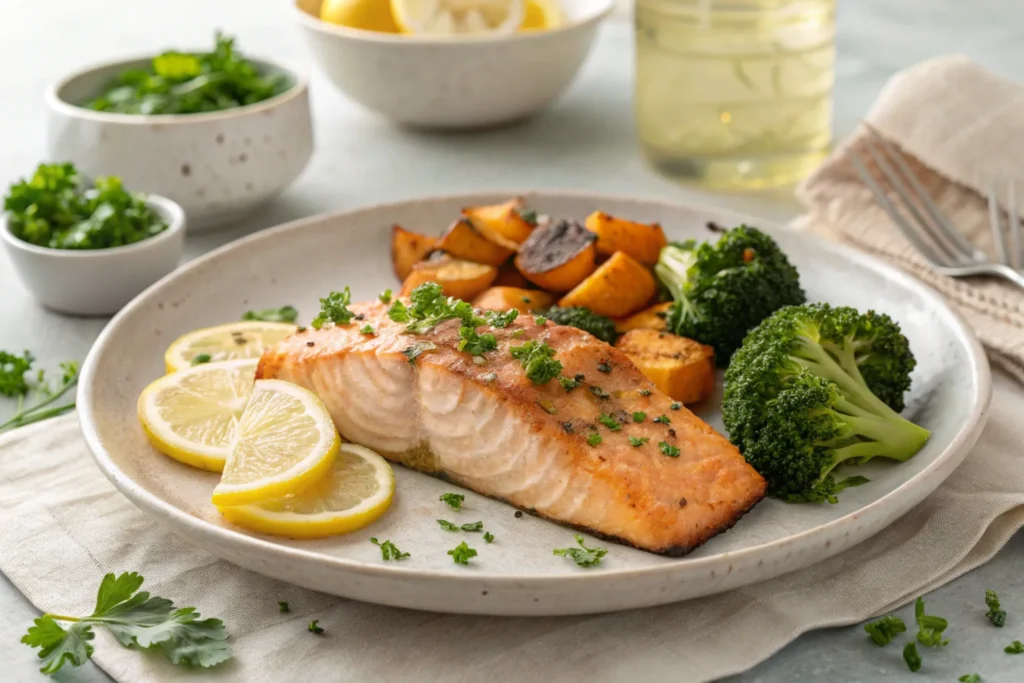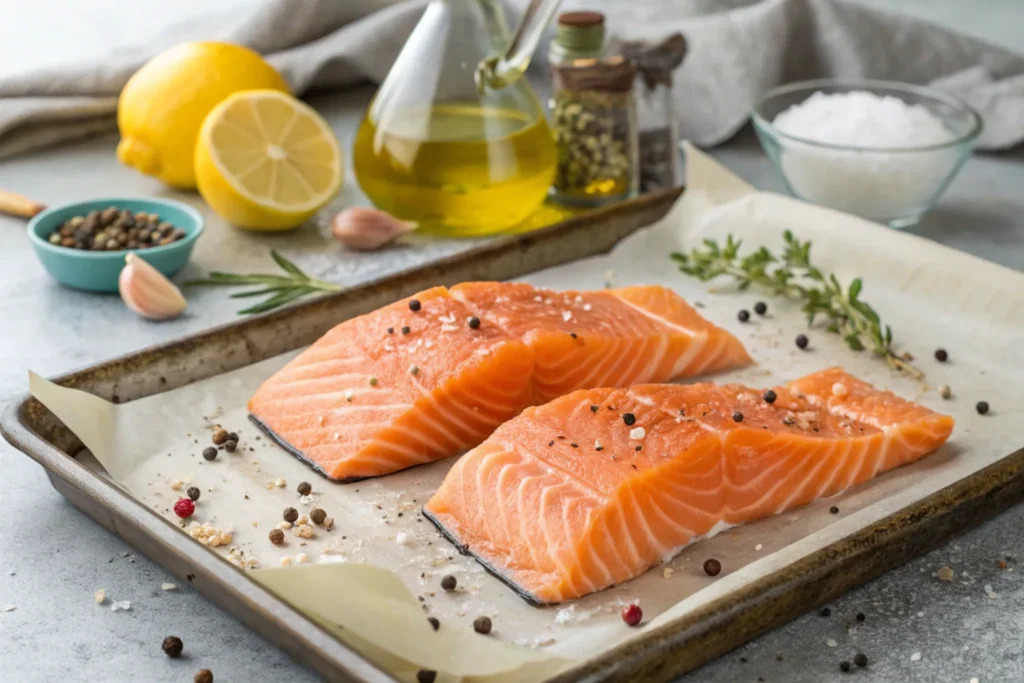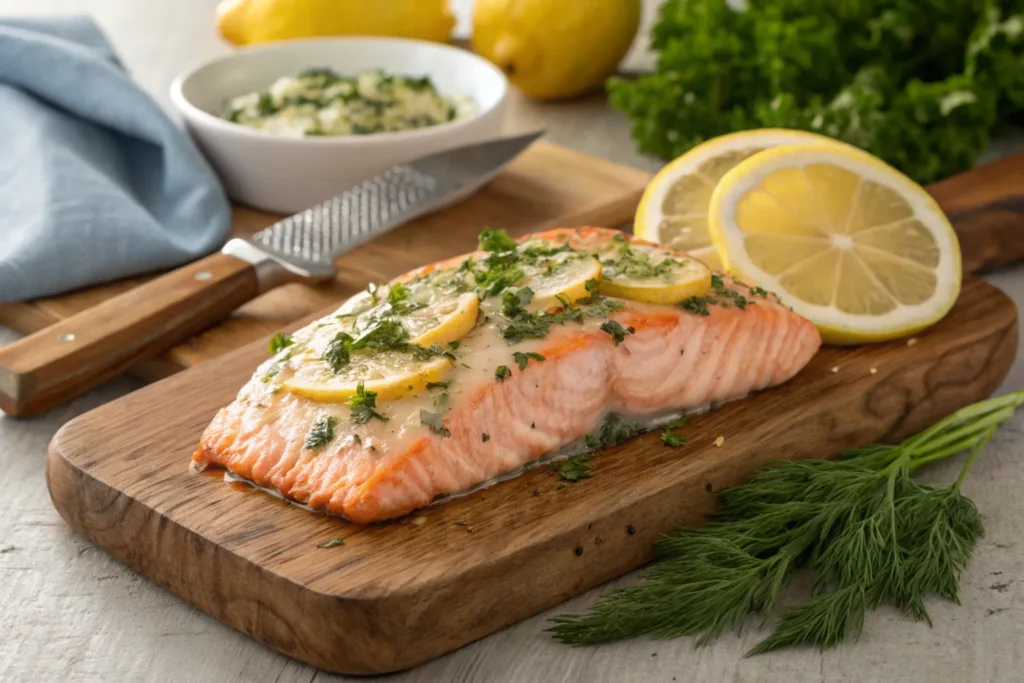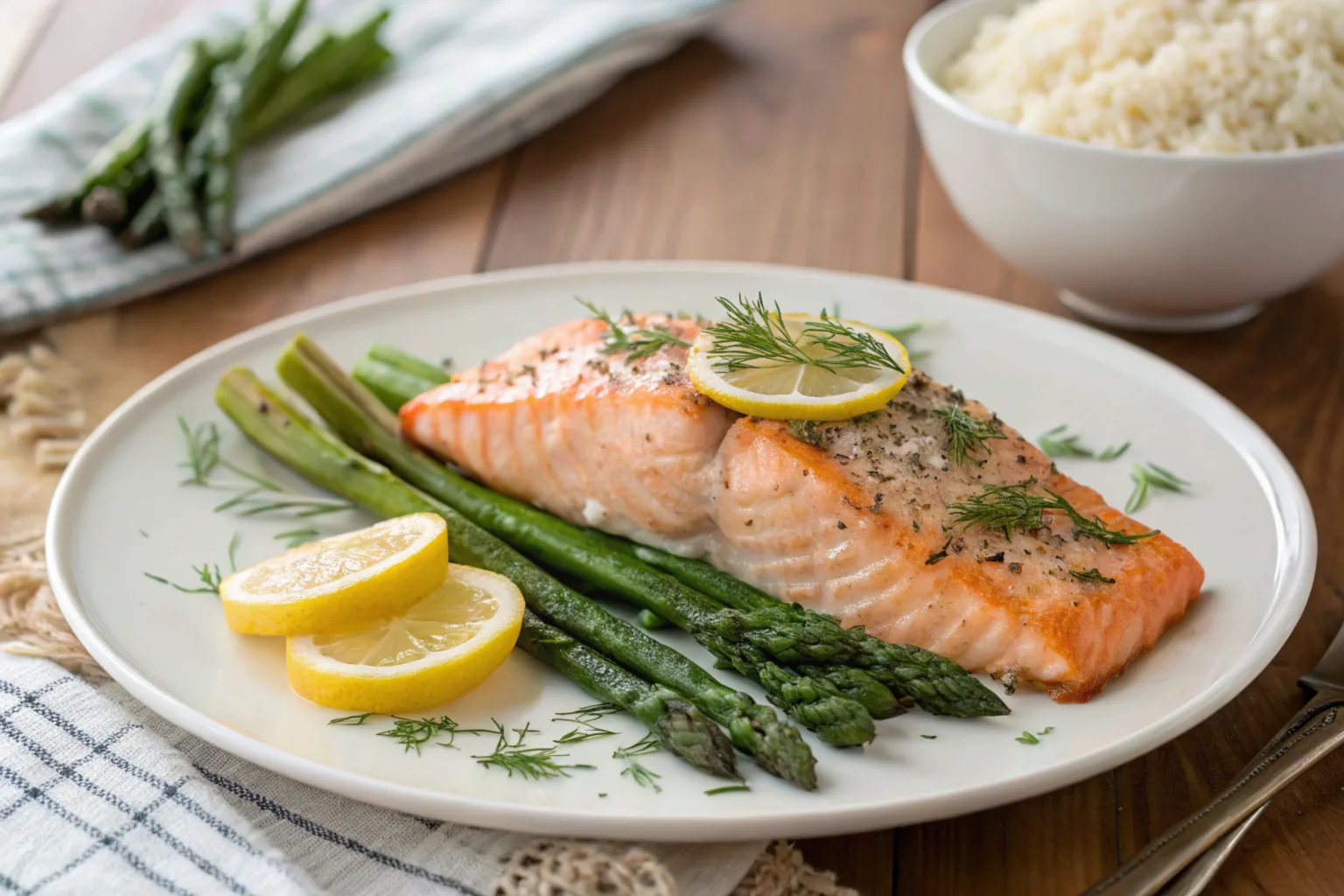Have you ever asked How Long to Bake Salmon at 350?!! Baking salmon at 350°F is one of the simplest and most reliable ways to achieve tender, flaky, and flavorful salmon. But how long should you bake it? This is a common question, and the answer depends on factors like the size of the fillet, whether it’s fresh or frozen, and how you want the final texture to be.
At 350°F, salmon cooks gently, preserving its natural moisture and allowing flavors to shine. Whether you’re baking a fillet with simple seasonings or adding a bold glaze like the one in this Baked Sweet Chili Salmon, timing is key to getting the perfect result.
In this guide, we’ll walk you through the ideal baking times for fresh, frozen, and whole salmon, plus tips and techniques to ensure your salmon is juicy and delicious every time.
Why Bake Salmon at 350°F?
Baking salmon at 350°F is the sweet spot for achieving tender, moist, and perfectly cooked fish. Here’s why this temperature is a go-to for home cooks and professionals alike about how long to bake salmon at 350:

1. Low and Steady Heat Preserves Moisture
Cooking salmon at 350°F allows the fillet to cook evenly and gently, preventing it from drying out. Unlike higher temperatures, which can leave the edges overcooked while the center remains underdone, 350°F delivers consistent results.
2. Ideal for Flavors and Seasonings
The moderate heat gives marinades, rubs, and glazes time to infuse into the fish. Whether you’re using a classic lemon-herb seasoning or a bold glaze like the one from Pineapple Sweet Chili Salmon, the flavors have room to develop without burning.
3. Perfect for Adding Glazes and Toppings
350°F is gentle enough to allow toppings like breadcrumbs, crushed crackers, or cheese to crisp up without overcooking the salmon. For example, try a twist on this Ritz Cracker Chicken Recipe by adapting the cracker topping for your salmon.
4. A Foolproof Option for All Cuts
From fillets to whole salmon, 350°F works across the board. It’s forgiving, making it a great choice whether you’re cooking fresh or frozen fish. Pair it with hearty sides like Southern Cornbread for a complete, satisfying meal.
By baking at 350°F, you’re setting yourself up for salmon that’s juicy, flavorful, and cooked to perfection.
How Long to Bake Salmon at 350?
The answer to how long to bake salmon at 350°F depends on the size, thickness, and type of salmon you’re cooking. Here’s a breakdown to help you get it just right:
For Fresh Salmon Fillets
Fresh salmon fillets, about 1 inch thick, typically take 20–25 minutes to bake at 350°F. The edges will be slightly crisp, and the center will flake easily with a fork. If your fillet is thinner, start checking for doneness around the 18-minute mark.
For Frozen Salmon Fillets
Frozen salmon takes a little longer—approximately 25–30 minutes. Be sure to bake it directly from frozen without thawing to retain moisture. Cover the salmon loosely with foil during the first half of baking to prevent it from drying out while it cooks through.
For Whole Salmon
Baking a whole salmon at 350°F requires 40–50 minutes, depending on its size. Stuff the cavity with lemon slices, fresh herbs, and garlic for extra flavor, and place the fish on a baking sheet lined with parchment or foil for easy cleanup.
Pro Tip: Use a Meat Thermometer
The USDA recommends cooking salmon to an internal temperature of 145°F. Insert the thermometer into the thickest part of the fish to ensure accurate results. For slightly softer salmon, aim for 135°F–140°F, as it will continue to cook while resting.
By adjusting your baking time to the type of salmon you’re cooking, you’ll end up with perfectly cooked, flaky fish every time.
Step-by-Step Instructions for Baking Salmon at 350°F
Baking salmon at 350°F is as easy as it gets. Follow these simple steps for perfectly cooked, flavorful salmon every time.
1. Prep the Salmon
To get the best results when deciding how long to bake salmon at 350, start by using fresh salmon, pat it dry with paper towels to remove excess moisture. This step ensures the seasonings stick and helps the fish cook evenly. If you’re baking frozen salmon, there’s no need to thaw it just rinse off any ice crystals and pat it dry.

Place the salmon on a baking sheet lined with parchment paper or foil for easy cleanup. Brush each fillet with olive oil or melted butter, then season generously with salt, black pepper, and any additional spices or herbs you like. For added flavor, drizzle lemon juice over the salmon or use a glaze like the one from this Baked Sweet Chili Salmon.
2. Bake the Salmon
Place the salmon in the oven, skin-side down if it has skin. Bake for:

- 20–25 minutes for fresh salmon fillets.
- 25–30 minutes for frozen fillets.
- 40–50 minutes for a whole salmon.
Halfway through baking, you can brush the fillets with more oil or glaze for added moisture and flavor.
3. Check for Doneness
Knowing how long to bake salmon at 350 isn’t complete without checking for doneness, to check if your salmon is done, use a fork to gently flake the fish. It should be opaque and flake easily. Alternatively, use a meat thermometer salmon is perfectly cooked when its internal temperature reaches 135°F to 145°F.
4. Rest and Serve
Remove the salmon from the oven and let it rest for about 5 minutes. Resting allows the juices to redistribute, ensuring every bite is tender and flavorful.
Transfer the salmon to a serving plate and garnish with fresh herbs, lemon wedges, or a light drizzle of olive oil. Serve it alongside roasted vegetables, rice, or a fresh side like Spicy Cucumber Salad Indian Style.
Tips for Perfectly Baked Salmon
Learning how long to bake salmon at 350 is just the beginning to achieve moist, tender, and flavorful salmon every time, follow these expert tips. These small adjustments can make a big difference in the final dish.
1. Use a Meat Thermometer
Salmon is best when it’s cooked to an internal temperature of 135°F–145°F. Insert the thermometer into the thickest part of the fillet for an accurate reading. For softer, slightly undercooked salmon, aim for 135°F, as it will continue to cook slightly while resting.
2. Don’t Overbake
Overbaking salmon can make it dry and rubbery. Start checking for doneness a few minutes before the recommended baking time ends. If the salmon flakes easily with a fork and is opaque in the center, it’s ready.
3. Cover Frozen Salmon with Foil
When baking salmon from frozen, cover it loosely with foil during the first half of baking. This traps steam, helping the fish cook evenly and retain moisture. Remove the foil midway through to allow the top to crisp slightly.
4. Pat Fresh Salmon Dry
Even if you know exactly how long to bake salmon at 350, resting for 5 minutes after baking locks in moisture on the surface of fresh salmon can prevent the seasonings from sticking and may lead to uneven cooking. Use paper towels to pat the fillet dry before brushing it with oil or adding spices.
5. Add Flavor with Glazes or Toppings
Enhance the flavor of your salmon with a glaze or topping. Try the sweet chili glaze from Pineapple Sweet Chili Salmon or a buttery herb mixture with garlic and parsley.
6. Use Parchment Paper or Foil
Lining your baking sheet with parchment paper or foil ensures easy cleanup and prevents the salmon from sticking. It also keeps the fish moist by trapping some steam during cooking.
7. Let the Salmon Rest
After removing the salmon from the oven, let it rest for 5 minutes. This step allows the juices to redistribute throughout the fillet, making it more tender and flavorful.
8. Experiment with Seasonings
While simple salt and pepper work well, don’t hesitate to try different spice blends. Cajun seasoning, lemon zest with dill, or even a touch of paprika can elevate the flavor. For inspiration, adapt the seasoning blend from this Pellet Grill Salmon recipe.
9. Use the Right Dish
A rimmed baking sheet works best for fillets, while a large roasting pan is ideal for whole salmon. Make sure there’s enough space around the fish for even heat circulation.
10. Pair with the Perfect Sides
Complement your baked salmon with sides like roasted asparagus, creamy mashed potatoes, or a light Rotisserie Chicken Casserole Stuffing for a hearty twist.
With these tips, your salmon will be a star dish every time.
Common Mistakes to Avoid
Even with a simple recipe, small missteps can affect the outcome when figuring out how long to bake salmon at 350. Here are the most common mistakes to avoid and how to fix them:
1. Overbaking the Salmon
The most common mistake is leaving salmon in the oven for too long, resulting in dry, tough fish. Avoid this by using a meat thermometer and removing the salmon once it reaches an internal temperature of 135°F to 145°F. Remember, salmon continues to cook slightly as it rests.
2. Skipping the Step to Pat Salmon Dry
Failing to pat fresh salmon dry before seasoning can lead to uneven cooking and prevent the seasonings from adhering properly. Always use a paper towel to remove excess moisture from the fillet before baking.
3. Not Adjusting for Thickness
Baking times vary depending on the thickness of the salmon fillet. A thicker cut needs more time, while thinner fillets cook faster. Start checking for doneness a few minutes early for thinner pieces.
4. Forgetting to Preheat the Oven
Placing salmon in a cold oven disrupts the cooking process, leading to uneven results. Always preheat your oven to 350°F before placing the salmon inside.
5. Using the Wrong Baking Dish
A flat baking sheet is ideal for fillets, while a deep roasting pan works better for whole salmon. Using the wrong dish can result in uneven cooking or excess liquid pooling around the fish.
6. Overcrowding the Baking Sheet
Crowding the salmon or adding too many sides on the same sheet can trap steam, preventing the fish from developing a nice texture. Give each fillet enough space for air to circulate.
7. Ignoring the Skin
Salmon skin acts as a barrier, keeping the fillet moist and preventing it from sticking to the baking sheet. Leave the skin on during baking and remove it after cooking if you prefer skinless salmon.
8. Adding Glaze Too Early
If you’re using a sweet glaze, brushing it on too early can lead to burning. Apply glazes like the sweet chili mixture from Baked Sweet Chili Salmon during the last 5–7 minutes of baking.
9. Forgetting to Rest the Salmon
Skipping the resting period can cause juices to run out, leaving the salmon dry. Let the fish rest for at least 5 minutes after baking to lock in moisture.
10. Overcomplicating the Recipe
Sometimes, less is more. Salmon is naturally flavorful, so a simple seasoning of olive oil, salt, pepper, and lemon can go a long way. For added depth, try a side like Spicy Cucumber Salad Indian Style.
By avoiding these mistakes, you’ll consistently bake salmon that’s moist, tender, and full of flavor.
Flavor Variations and Pairing Ideas
Knowing how long to bake salmon at 350°F gives you the perfect canvas to get creative with flavors and sides. Here are some ideas to elevate your dish and make it unique every time.
Flavor Variations
1. Herb and Lemon
Combine olive oil, minced garlic, lemon zest, and fresh dill or parsley. Spread it over the salmon before baking for a light, citrusy flavor that’s perfect for any occasion.
2. Sweet and Spicy
Brush the salmon with a glaze made from honey, soy sauce, and a dash of sriracha. This sweet-and-spicy combo is irresistible and pairs beautifully with roasted veggies.
3. Cajun Kick
Rub the salmon with Cajun seasoning, olive oil, and a pinch of smoked paprika. This bold, spicy flavor works well with simple sides like rice or steamed broccoli.
4. Mediterranean Twist
Top the salmon with diced tomatoes, olives, garlic, and a sprinkle of feta cheese. Bake until the toppings are bubbly and the salmon is tender.
5. Maple Mustard
Mix Dijon mustard, maple syrup, and a splash of apple cider vinegar. Spread it over the salmon before baking for a tangy-sweet glaze.
6. Garlic Butter
Combine melted butter, minced garlic, and a pinch of parsley. Drizzle it over the salmon before baking for a rich, indulgent flavor.
Pairing Ideas
1. Light and Refreshing Sides
- Serve your salmon with a crisp salad like Spicy Cucumber Salad Indian Style for a fresh contrast to the rich fish.
- For a creamier option, try a Southern Cornbread Recipe as a fun Southern twist.
2. Hearty Comfort Foods
- Pair the salmon with roasted sweet potatoes or garlic mashed potatoes for a filling, satisfying meal.
- Add a serving of Rotisserie Chicken Casserole Stuffing as a unique and hearty side.
3. Grilled or Roasted Vegetables
- Roasted asparagus, zucchini, or bell peppers complement the natural richness of salmon.
- For a smoky flavor, consider grilling the vegetables, like the method used for Pellet Grill Salmon.
4. Rice and Grains
- Jasmine or wild rice provides a neutral base for bold salmon flavors.
- Try quinoa or couscous for a slightly nutty, healthy pairing.

How To Bake Salmon at 350°F ?
Ingredients
Equipment
Method
- Preheat oven to 350°F. Pat salmon dry with paper towels.
- Place salmon skin-side down on a lined baking sheet. Brush with olive oil or melted butter and season with salt, pepper, and desired herbs.
- Bake for 20–25 minutes for fresh fillets, 25–30 minutes for frozen, or 40–50 minutes for whole salmon.
- Check doneness with a fork or thermometer (135°F–145°F internal temperature).
- Let rest 5 minutes before serving. Garnish with lemon wedges or fresh herbs.
Nutrition
Notes
Tried this recipe?
Let us know how it was!Conclusion
Knowing how long to bake salmon at 350 is a foolproof way to achieve tender, flaky, and flavorful fish every time. Whether you’re cooking fresh fillets, frozen portions, or even a whole salmon, the key is to monitor the cooking time and use simple techniques like patting the fish dry, seasoning generously, and checking for doneness with a meat thermometer.
With a wide range of flavors and sides to explore, baked salmon can be a versatile centerpiece for any meal.
By mastering the art of baking salmon at the right temperature and time, you’ll have a healthy, delicious dish that’s perfect for weeknights, family gatherings, or entertaining guests. So next time you’re in the kitchen, set your oven to 350°F, follow these tips, and enjoy perfectly baked salmon every time!
LET’S STAY CONNECTED! FOLLOW ME ON:
Tried this recipe? I’d be thrilled to see your take on it! Snap a pic and tag me @Sweftyrecipes so I can share your delicious creations with our foodie community.
→ FACEBOOK | INSTAGRAM | PINTEREST
FAQs: Baking Salmon at 350°F
How long should salmon be in at 350?
Salmon fillets take 20–25 minutes at 350°F. Frozen salmon requires 25–30 minutes, while whole salmon bakes for 40–50 minutes.
Is it better to bake salmon at 375 or 400?
Both temperatures work well, but the choice depends on your desired texture. Baking at 375°F is ideal for slightly faster cooking while maintaining moisture. At 400°F, salmon cooks quicker and develops crispier edges, which is perfect if you’re using a glaze or topping like the one in this Baked Sweet Chili Salmon. For tender, juicy salmon, 350°F is an excellent option.
How long does it take to grill salmon at 350 degrees?
Grilling salmon at 350°F takes about 10–15 minutes for fillets and up to 30 minutes for a whole fish. Always place the salmon skin-side down to protect it from direct heat and ensure even cooking. For a smoky flavor, try the method used in this Pellet Grill Salmon recipe.
What is the best temperature and time to cook salmon?
The best temperature depends on your method:
350°F–375°F: Perfect for baking tender and moist salmon (20–25 minutes for fillets).
400°F: Ideal for achieving crispier edges in less time (12–15 minutes for fillets).
For grilling, 350°F works well for 10–15 minutes. The key is to ensure the salmon reaches an internal temperature of 135°F–145°F.
How do you not overcook salmon in the oven?
To avoid overcooking, use a meat thermometer to check the internal temperature. Remove the salmon from the oven when it reaches 135°F and let it rest for 5 minutes.
Do you turn salmon over when baking?
No, you don’t need to turn salmon over when baking. Baking it skin-side down provides a barrier that protects the delicate flesh and ensures even cooking.

Comments are closed.